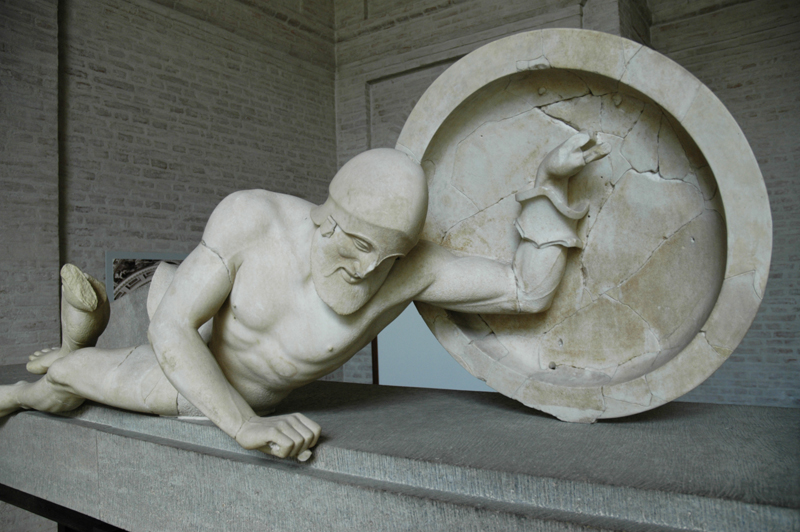
This “Dying Warrior” is a Pediment Sculpture from the Temple of Aphaia. It is believed to represent a fallen Trojan hero, probably Laomedon. It was initially part of the east pediment of the Temple of Aphaia, created about 505–500 BC.
The Greeks idolize heroes who had fallen in war. To die on the battleground was a great honor, and it was depicted with courage and strength in their art. When a hero died, The Greeks believed that they become immortal because they had proved themselves to the gods.
The marbles are also beautifully finished on the back surfaces of the figures; even though the back of the pediment sculptures was not visible to the human eye, they were visible to the Greek gods.
This marble sculpture is part of a collection of marbles from the Late Archaic temple of Aphaia, comprising the sculptural groups of the east and west pediments of the temple, which are on display in the Glyptothek of Munich.
These works exerted a strong influence on Neoclassicism art and architecture in Munich and Germany. The influence was similar to the impact that the Acropolis Marbles in the British Museum had on British artists and architects.
Each pediment centered on the figure of Athena, with groups of combatants, fallen warriors, and arms filling the decreasing angles of the sediments.

Reconstruction of the Eastern Pediment of the Temple of Aphaia at Aegina
The theme shared by the pediments was the greatness of Aigina, as shown by the exploits of its local heroes in the two Trojan wars, one led by Heracles against Laomedon and a second led by Agamemnon against Priam.
The sculptures preserve extensive traces of an elaborate paint scheme and are crucial for the study of painting on ancient sculpture.
The Temple pedimental sculptures illustrate the change from Archaic to Early Classical technique.

Fallen Trojan warrior of the West Pediment in an earlier Archaic Style
Both of these sculptures of the Archaic and the Early Classical technique are on display in the Glyptothek of Munich.
Temple of Aphaea
The Temple of Aphaia is located within a sanctuary complex dedicated to the goddess Aphaia on the Greek island of Aigina, which lies in the Saronic Gulf.
The great Doric temple was a favorite of the neoclassical and romantic artists such as J. M. W. Turner. It stands on a 160 m peak on the eastern side of the island.
Aphaia was a Greek goddess who was worshipped exclusively at this sanctuary. The surviving temple from about 500 BC was built over the remains of an earlier temple, which was destroyed by fire.
The elements of this destroyed temple were buried in the infill for the more extensive, flat terrace of the later temple, and are thus well preserved.

Temple of Aphaia on the island of Aegina near Athens, Greece
Laomedon
In Greek mythology, Laomedon was a Trojan king. He was the father of the legendary King Priam of Troy.
Heracles mustered an army of noble volunteers and sailed for Ilium to attack the city. Laomedon marched against Greeks, but being repulsed by the troops of Heracles, Laomedon was besieged.
The siege once laid, Telamon was the first to breach the wall and enter the city, and after him Heracles. When the son of Zeus had taken the city he shot down Laomedon.
“Dying warrior” – Pediment Sculpture from the Temple of Aphaia
- Title: Dying Warrior
- Built: 505–500 BC.
- Material: Marble
- Origins: Pediment Sculpture from the Temple of Aphaia, Greece
- Museum: Glyptothek
A Tour of Greek Genius
- Acropolis of Athens
- Acropolis Museum
- National Archaeological Museum
- The Parthenon Marbles
- The Parthenon Frieze
- Metopes of the Parthenon
- Pedimental Sculptures of the Parthenon
- The British Museum
The Temple of Aphaia at Aegina
Aphaia temple in Aegina
Temple of Athena Aphaia, Aegina
~~~
“What you leave behind is not what is engraved in stone monuments, but what is woven into the lives of others.”
– Pericles
~~~
Photo Credits: 1)Glyptothek / CC BY CreativeCommons.; Creator:Adolf Furtwängler (died 1907) / Public domain; Runner1928 / CC BY-SA creativecommons.
Popular this Week








 Sponsor your Favorite Page
Sponsor your Favorite Page SEARCH Search for: Search Follow UsJoin – The JOM Membership Program
Sponsor a Masterpiece with YOUR NAME CHOICE for $5
Share this:
- Tweet
